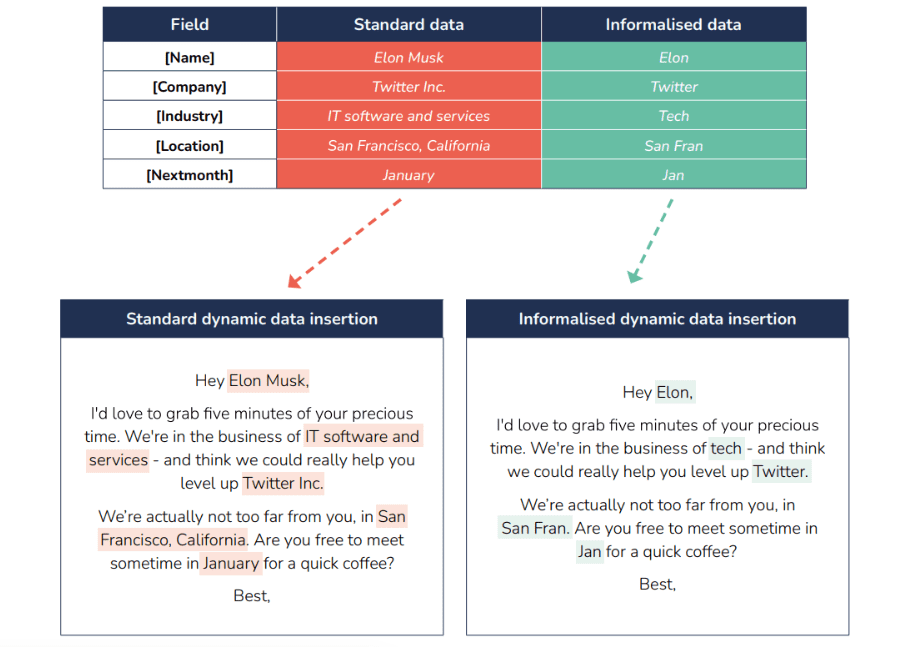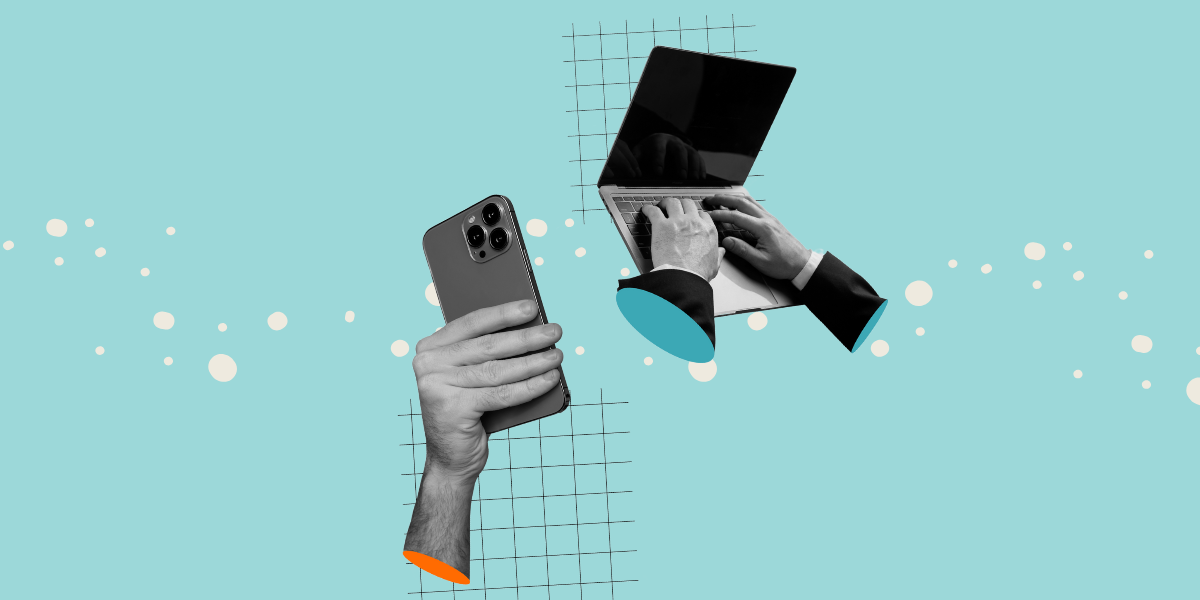Go beyond name and company: How to nail personalisation in cold emails

Here’s the thing: most cold emails are boring and impersonal. Automation is great for adding personalisation, but relying too heavily on it can make your messages sound spammy and generic.
Here’s how to create personalised cold emails that actually get results.
Why is personalisation important with cold emails?
With the average open rate of B2B emails at just 15%, it’s crucial to create customised email content that’s relevant to your audience. Recipients should feel like you understand their specific needs and challenges, rather than just being another email address in your database.
Personalisation is also a key factor in avoiding your emails getting marked as junk. Spam filters can spot mass emails a mile off, but if you’re sending a batch of emails that differ in their content, you’re less likely to get flagged.
As a start, our State of Prospecting 2024 data shows that just adding a prospect’s first name to the subject line can increase open rates by 9.1%. But getting them to open the thing is only the first hurdle. You want them to read, engage, and respond to your message.
So how do you take personalisation further?
Why first name and company name is no longer enough
It’s tempting to just stick a **[First name]** and **[Company name]** in your emails and call it a day. And back when email marketing was first a thing, this would have been impressive to do at scale. Now it’s pretty much the bare minimum.
Real personalisation in sales emails goes beyond these now fairly standard practices. You definitely want to include those fields in your messages (when was the last time you ever responded to a “Dear sir/madam” email?) but you need to get clever with it, especially if you’re using any form of marketing automation to put your cold emails together.
We’re not saying you have to do hours of research and write an essay on each potential client, but simple things like mentioning where you found your prospect, a notable event they’ve got coming up, or mentioning similar brands you’ve helped can all boost your lead rates and get you conversations with potential clients.
Finding the balance between automation and personalisation
OK, so we know that personalisation is the key to good cold email copywriting. But it’s often misused and misunderstood, especially when you’ve got clever tools like marketing automation software helping you send multiple emails at once.
One of the biggest mistakes you can make is to shoehorn in too many different personalisation fields just for the sake of it. More doesn’t always mean better! The most effective cold emails are the ones that feel natural and human.
Emails that start with “In your role as Chief of Massively Long Job Title at Full Legal Company Name Ltd” are so far removed from what a natural conversation actually feels like, that your effort to be as personal as possible ends up tipping the scales – making your carefully crafted email look like a cheap copy-and-paste job.
How to avoid uncanny valley in automated cold emails
While you need automation to be able to send messages at scale, how do you use automation… without feeling automated?
Recent AI developments have made the content creation process much faster, but relying on it too heavily for your email personalisation will only add to the uncanny valley effect.
Automated personalisation works best when you’re trying to hook your prospects into a conversation away from email, such as inserting fields that specify a weekday for a sales call.
We’ve received a lot of cold emails recently where it’s clear that a job title has been pulled from LinkedIn and fed through ChatGPT in order to create some semblance of a personalised email. It just feels odd, and in our experience leads to very low lead rates.
But in a world where everyone’s jumping on the AI bandwagon, you can use dedicated email personalisation tools and services to cut through the computer-generated clutter. Here’s an example of how Sopro uses clever technology to “informalise” customer data to make your cold emails feel natural, human, and personal.

Cold email personalisation best practices
Personalising your cold emails increases open rates, boosts engagement, and brings better lead rates. So here’s five best practices to remember when sending personalised cold emails.
1. Cut the marketing speak
Email marketing content doesn’t work for cold sales emails. So throw away all that carefully curated marketing copy, because nothing screams “mass email” more than a beautifully designed HTML template.
Your prospecting emails should feel human, one-to-one, and as if you’ve written a quick note on a whim. Avoid industry jargon and try not to use bullet points; they look great on paper, but would you really use them in a message to a colleague or friends? Leave them out and you’ll get more responses.
2. Don’t stuff your message with mailmerge fields
As previously mentioned, stuffing as many personalisation fields as you can in an email will turn your prospects off. And the stats back this up: three different personalisation points is optimum. Any more than that and you’ll start to see a drop in conversion rates.
3. Show you’ve done your research
Can you find any intriguing aspects about your prospect’s organisation that you could include in your email? Maybe they recently launched an innovative product, or they received recognition in a prominent industry publication.
It’s a simple yet powerful method that proves you’ve done your homework.
For example:
“Exciting partnership with XYZ Ltd! Would love to hear more about your collabs in the coming months.”
“As you’re using XYZ CRM, I thought you might be interested in this new integration.”
4. Share success stories that resonate with them
When including case studies in your cold emails, using attributes ensures that each prospect gets the most relevant case study.
For example, if your prospect has a SaaS business focused on marketing, you can mention a similar company. If they work in recruitment, you can refer to another company where they would recognise the client’s name.
For example:
“I work with organisations like **[Marketing_Case_Study]** and produce weekly videos for their blog.”
“I partner with companies like **[Recruitment_Case_Study]** and help them generate new business with Facebook Ads.”
5. Don’t go for the hard sell, aim to get them on a call
Suggesting a day for a sales call is an underrated but super effective form of email personalisation. Using a time-based tag that pulls through a time in two to three working days will nudge your prospects toward a response, more than chucking in their full job title or legal company name ever will.
Once you’ve put your email together, there’s only one thing left – the sign-off. Our guide explores how to end sales emails.
Send personalised emails that generate leads at scale with Sopro
From dodging spam filters to making meaningful connections, sending mass cold emails – that are personal to each recipient – can feel impossible.
Luckily, with Sopro, finding and engaging with your ideal customers is a piece of cake. Our fully-managed service uses smart technology and up-to-the-minute data to reach out to the right people with the right message. So you can sit back and watch those high-quality leads roll in.
Better personalisation, better engagement, more time to sell. See how it works.

Looking for a lead generation agency for financial services companies? Or maybe you’re after a lead generation agency for staffing and recruitment companies. Look no further than Sopro. We’ll develop messaging that resonates with the decision-makers you need to sway.
Sopro is a B2B email marketing agency that has refined outreach to a fine art. We’ve sent millions of emails and are constantly evolving our efforts to suit your target market and increase your bottom line. See our email marketing for lead generation strategies for insight into what we do and how we do it.
To really nail your email strategy, take the next step and read our guide to discover the best time to send prospecting emails.




Share